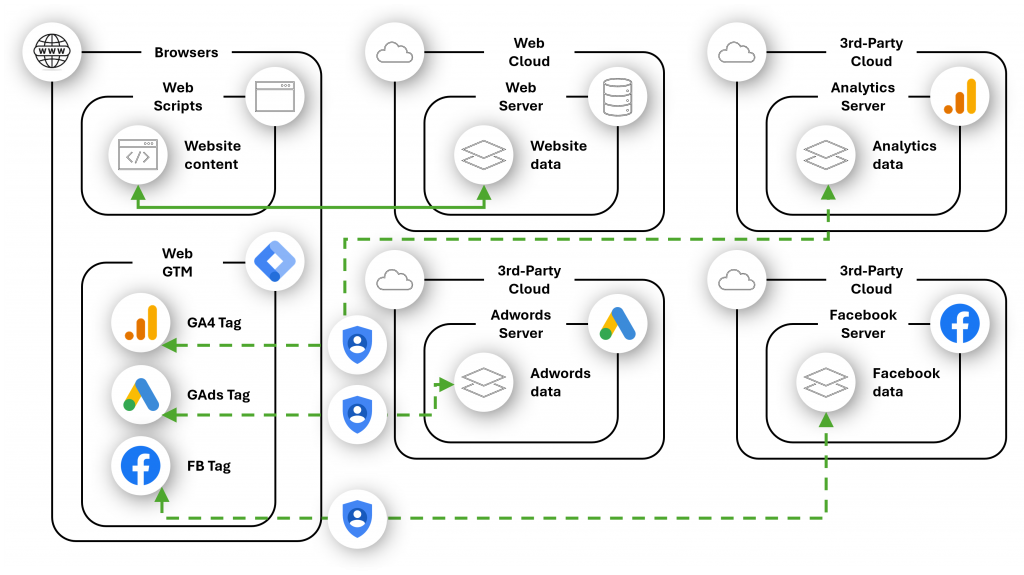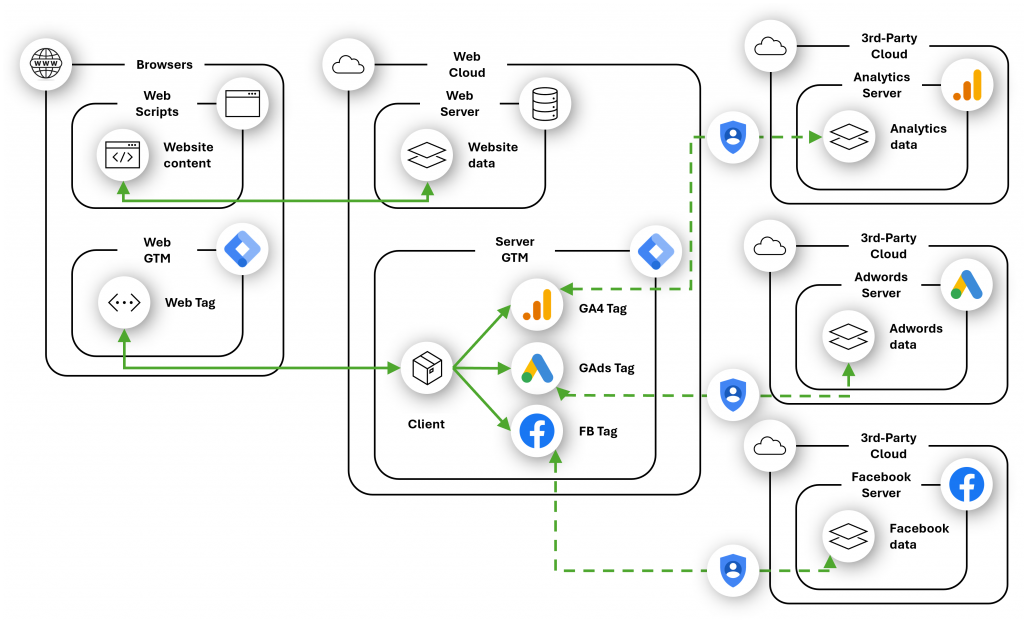Upcoming changes in privacy laws and browser technology are presenting marketers and analysts with new challenges. The phasing out of third-party cookies, browser restrictions such as those imposed by Safari and Firefox, and the increasing prevalence of ad-blocker tools are making traditional user tracking and effective ad targeting more difficult. Google is also considering phasing out cookies in the Chrome browser, further complicating the situation.
As a result, marketers have limited access to user data, which affects the quality of analytics. Traditional methods are losing effectiveness, and new regulations are forcing the introduction of more advanced solutions, such as Google Tag Manager on the server side (server-side GTM). This approach not only maintains the effectiveness of marketing efforts but also provides greater control over data and compliance with new regulations.
Why is server-side GTM the answer to phasing out third-party cookies?
With the elimination of third-party cookies and the restrictions imposed by browsers, a key challenge for marketers and analysts is finding new ways to collect data effectively. Server-side GTM offers an alternative approach to data processing and tag management, providing more efficient and secure user tracking. How exactly does it work, and how does it differ from the traditional web-based version of Google Tag Manager?
What is server-side GTM?
Server-side GTM is a server-side container of Google Tag Manager, where processing takes place on the server rather than in the user’s browser. Tagging activities are moved to a dedicated server, which acts as an intermediary between the user’s device and analytics and advertising tools. This gives companies more control over how data is processed and to who it is sent.
Differences between web-based and server-based GTM
Web GTM: In traditional web GTM, all tags (scripts) are run directly in the user’s browser, making them vulnerable to browser blockers and ad-blockers. This can negatively impact site performance and limit data control.

Server-Side GTM: In the server-side version, tags run on the server, bypassing browser limitations, improving performance, and enhancing user data security.

Advantages of moving operations to the server
- Better control over data: Companies can decide which data is sent to external analytics and advertising tools, increasing security and ensuring privacy compliance.
- Bypassing browser blockers: Transferring tags to the server allows for more effective tracking, even when the browser blocks cookies and scripts.
- Improving site performance: Reducing the number of tags running in the browser offloads the site, decreasing loading times and enhancing user experience.
Container collaboration in server-side GTM
Server-side GTM works in conjunction with the GTM web container and the gtag.js library. Data collection occurs in the browser, which is then sent to the server-side tagging environment. In practice, server-side tagging utilises two containers simultaneously:
- The web container (webGTM) located on the website.
- A server-side container (sGTM) located in the cloud environment.
Once you understand what server-side GTM is and how it differs from the web-based version, it is essential to explore how this solution can provide practical benefits for companies. Implementing server-side GTM allows for more precise data tracking while bypassing the limitations of privacy laws and browser blockers. Let’s look at how to use data effectively while minimising the risk of privacy breaches.
How does server-side GTM help in practice?
Server-side GTM (sGTM) acts as a complement to the web container, shifting the processing of resource-intensive operations to the server — previously handled in the user’s browser. In the traditional model, tags were processed on the client side, often leading to being blocked by browsers and ad-blockers. With sGTM, tags are handled on the server, circumventing these limitations while providing full control over the data being transmitted.
The main benefits of implementing GTM on the server side:
- More precise data collection:
Server-side data processing eliminates the limitations imposed by browser blockers and ad-blockers, ensuring accurate data collection.
- Bypassing browser blockers:
Tags running on the server can collect data independently of the blockers used by browsers.
- Better control over user data:
Companies can filter and modify data before sending it to external analytics tools, increasing security and compliance with GDPR.
- Performance optimisation and budget management:
Reducing the number of tags running in the browser accelerates website operations. Companies can also monitor computing costs on cloud platforms like Google Cloud, avoiding unexpected spikes in expenditure.
Server-side GTM not only offers tangible benefits but is also a solution that will play a key role in the future of digital marketing. In a world without cookies, tools that can efficiently collect and process data without relying on third-party cookies will be essential for every marketer and analyst.
Server-side GTM and a cookie-less future
With increasingly stringent privacy regulations like GDPR and the phasing out of third-party cookies, companies must adapt their approach to data collection. Server-side GTM is not only a response to these changes but also a preparation for a future where user tracking will comply with tighter regulations.
How to prepare a company for a future without cookies?
- Move tags to the server: Minimise reliance on scripts running in the browser to ensure continuity in data collection.
- Use alternative tracking methods: Implement solutions such as User-ID and server-side APIs that function without third-party cookies.
- Integrate analytics tools: Introduce tools like Google Analytics 4 and Facebook Conversions API, which are compatible with the server-side version and enable more accurate tracking.
Preparing for the migration requires careful infrastructure planning, testing, and an understanding of the specific analytics and marketing tools used in your daily operations. As a result, this process will not only improve data collection but also ensure compliance with new privacy regulations.
Summary
Server-side GTM is the tool of the future, allowing marketers and analysts to efficiently collect data while bypassing the limitations imposed by browsers and ad-blockers. Migrating to this solution helps maintain the effectiveness of your marketing efforts in the post-cookie era while providing better data control and compliance.
If you want to enhance your company’s analytics, fill in the form below. Our specialists will provide you with a personalised quote and help you optimise your data management and implement modern analytics solutions.






